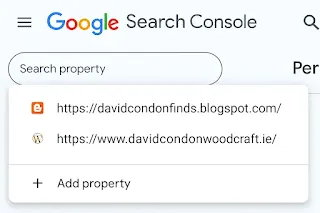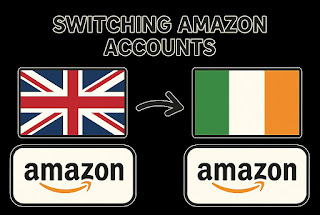Worried No One Is Seeing Your New Blog? This Free Google Tool Can Help
Why Isn’t Google Indexing Your New Blog? You’re Not Alone
Have you set up a new blog recently? Are you struggling to figure out why Google hasn't crawled or indexed your new pages yet? You're not alone.
I went through this same issue myself, and I decided to write this post to help and advise anyone else in the same boat. This post also applies to new website owners and has some helpful tips.
Check out my other post Blogging for Your Small Business: A Practical Guide for tips and practical suggestions after you finish here!
Why I Started a New Blog (and What Went Wrong Before)
I recently launched a new Blog on Blogger, moving and rewriting content that originally lived on my main website. Why?
Well, I'm a woodturner and my main site is primarily focused on woodturning and handmade woodcrafts. Over time, I started adding blog posts covering all kinds of topics - tech, health, even product reviews. I had hoped the variety would bring in more traffic, but instead, I think it confused Google and diluted my site’s focus.
I didn't want to be penalised by Google for my off-road posts so I made a change. I split off that content into a dedicated blog on Blogger.
A Quick Note Before We Start
I’m fairly experienced with websites, internet jargon and internet tools, so I won’t go into micro-level steps here. This is a general guide. If you’re brand new or stuck on a specific part, drop me a comment and I’ll expand a section or two in a future update.
FYI: I will be referring to Google Search Console as GSC to save time and space in this post.
What You Should Already Know
Before we dive in, I’ll assume you’ve already:
- Set up your blog (e.g. Website, Blogger, WordPress, etc.)
- Written a few initial posts.
- Created or accessed your Google Search Console (GSC) account
If you haven’t set up GSC yet, it’s usually quick to do — especially if you’re already signed into Google for Gmail, YouTube, or other services.
Tip: If you haven’t written any posts yet, hold off on submitting your blog to Google Search Console. Wait until you’ve published at least a few posts so Google has something to scan and evaluate. A totally empty blog won’t give Google much to work with and might even slow down indexing later.
If that’s all done, let’s get started.
Step 1: Add Your Blog to Google Search Console
Once your blog is live and you’ve published your first 3 or 4 posts, your next job is to connect it to Google Search Console.
Here’s how:
- Log into your GSC account
- Click “Add Property” from the top left of the page.
- Paste in your blog’s URL into the URL prefix field (e.g. https://yourblogname.blogspot.com)
Once that’s added, GSC will start tracking your site’s visibility in search results. Not immediately though, it takes a few days.
Step 2a: Submit Your Sitemap
Your sitemap tells Google how your content is structured and which pages to crawl. It’s important, even for a simple blog.
In GSC:
- Click on “Sitemaps” in the left-hand menu.
- You’ll then see a box like this: https://yourblogsitename.blogspot.com/
- In the empty space next to it, type: sitemap.xml
So the full entry will look something like:
https://yourblogsitename.com/sitemap.xml
Click submit, and you’re done.
Step 2b: Add a Feed URL as a Sitemap (For Blogger Users)
If you're using Blogger, your blog doesn’t have a traditional sitemap.xml file like a self-hosted WordPress site would. But you can still help Google find your content using your blog's feed URL.
Here’s how to do it:
In GSC:
- Click on “Sitemaps” in the left-hand menu.
- You’ll see a box like this: https://yourblogsitename.blogspot.com/
- In the empty space next to it, type: feeds/posts/default?orderby=updated
So the full entry will look something like:
https://yourblogsitename.com/feeds/posts/default?orderby=updated
Click submit, and you’re done.
Why Use This Feed instead of sitemap.xml?
This feed includes your blog posts in order of their last update. It helps Google discover:
- Your newest content
- Older posts you’ve recently edited or updated
Even though it's not a traditional sitemap, Google accepts this format for Blogger and will use it to crawl your blog effectively.
Like what you're reading? You can buy me a coffee — sure it’s cheaper than a pint!
The Hard Part: Waiting for Google
So, your blog is live, your sitemap is submitted - now comes the hard part: the wait.
Google isn’t always in a hurry to index content from new or unknown blogs. You’re starting from scratch in their eyes, so you need to build a bit of momentum. Here's how to help that along.
You will have to be patient and wait, I know it's hard - I've been there and I'm still currently going through it.
Stay Consistent and Link Internally
- Post regularly: Aim for 2–3 posts per week if possible. Consistency shows Google you're active and serious.
- Link between your posts: Add internal links where relevant, like “As I mentioned in my last post...” or “Related: How to Add a Sitemap to GSC.” Keep it natural - avoid robotic-sounding link stuffing.
Manually Request Indexing in GSC
Each time you publish a new post:
1. Copy your blog post’s URL.
2. Go to Google Search Console, and paste the URL into the search bar at the top where it says:
Inspect any URL in https://yourblogsitename.com/
What Happens Next?
Once you’ve submitted the indexing request, Google will get to it in their own time. From my experience, it takes about 7 days for new posts on a fresh Blogger blog to show up and sometimes longer. It's a pain, but part of the process.
What If Indexing Fails?
If your pages don’t get indexed, don’t assume the worst but do investigate:
- Is the content too thin or duplicated?
- Are you using too many tags or labels that might confuse the crawler?
- Are your posts accessible (no broken links, no permissions issues)?
- Are you flooding Google with too many changes too quickly?
If you get a specific error, check the Coverage or Page Indexing section in GSC for clues. Sometimes Google just doesn't want to know your page, that's ok - give it another week.
How to Troubleshoot Indexing Errors
If your post isn’t getting indexed, don’t panic, it happens. But it’s worth checking for common issues that might be stopping Google in its tracks.
Here are a few things to look out for:
-
Content quality: Is the post thin, repetitive, or missing useful information? Make sure it offers some value.
-
URL issues: Double-check the post is live and doesn’t return a 404 error. Test it in an incognito window to be sure.
-
Blocked by robots.txt or noindex tag: Unlikely for Blogger, but worth confirming in the GSC Page Indexing section.
-
Crawl budget overload: If you've added 30+ posts in one go, Google might slow down. Spread them out a bit instead.
-
Spammy practices: Avoid excessive keyword stuffing, overly promotional tone, or dodgy outbound links.
In GSC, go to Indexing → Pages, click on any URL that's showing an error, and read the explanation. Sometimes it’s as simple as “Discovered – currently not indexed,” which means Google found it but hasn’t made a move yet.
Signs Your Blog Is Gaining Google’s Trust
Here’s how to know you’re making progress, even if it feels slow at first:
-
✅ Pages start showing as indexed in GSC without you manually requesting it
-
📈 Impressions appear in the Performance tab, even with no clicks (means you’re being seen!)
-
🔗 Your older posts get crawled again - check GSC’s crawl stats for signs
-
🌐 New posts are indexed faster, sometimes within a day
-
🕵️♂️ You start ranking for long-tail searches, like “how to add sitemap Blogger GSC”
Google’s trust builds over time. Keep posting regularly, link your content together naturally, and resist the urge to overhaul your whole blog every other week. Stability is your friend.
Getting Your Blog Out There
While you’re waiting for Google to catch up, don’t be afraid to give your blog a little push:
-
📣 Share your posts on social media – Facebook, LinkedIn, Reddit, wherever your audience hangs out.
-
👨👩👧👦 Ask friends and family to visit, share, or comment - early engagement can help kick-start visibility.
-
🔍 Register with Bing Webmaster Tools – Yes, it’s Google’s competitor, but getting indexed there is worth it. You might even find Bing picks you up faster than Google.
Every little bit of exposure helps build momentum and lets search engines know your site is active and worth crawling.
Final Thoughts: The Long Game
Building up a blog from scratch can feel slow - sometimes painfully slow. But if this is something you care about, it will pay off in time.
Stick with it. Post consistently. Improve a little with each article. And remember: even the biggest sites started with zero traffic.
You’re not just writing for Google. You’re writing for the real people who will eventually find your posts and appreciate what you have to say.
One Final Tip
Before I wrap up, here’s one last piece of advice:
Go back over your posts a month or two after publishing. Then revisit them every six months or so, you’ll likely find you’ve become a better writer and spot things you missed or could improve.
Google notices when you update and refine your content. It shows you’re maintaining your blog, and that can really help with long-term visibility.
Have fun writing and if you found this helpful, feel free to let me know how you got on in the comments below.
Thanks for reading,
David
Maybe You Would Like to Read:
Why Google Ads Is So Hard for Small Businesses: An Open Letter to Google
Why the LEGO UCS Venator Is My Next Purchase
💬 Got thoughts or feedback? Feel free to leave a comment and let me know how you got on!
About the Author
I’m David Condon, a writer and small business owner based in Tralee, Co. Kerry. Most of my working life revolves around woodcraft and teaching woodturning, but this blog is where I share thoughts and discoveries from beyond the workshop — from everyday experiences to product reviews and tech finds that make life a little easier.
If you’d like to know more, there’s a link in the Note from the Author section below.
💬 Note from the Author
This post was written specially for David Condon Finds. If you enjoyed it, you might also like my other projects:
Phoenix DVD Blog – where I write about DVDs, Blu-rays, and life as a collector
David Condon Woodcraft – my main site focused on woodturning and handmade Irish pieces
If you’d like to support my writing, you can do so through the Buy Me a Coffee button below. It helps keep these side projects going — thank you!
Like what you're reading? You can buy me a coffee — sure it’s cheaper than a pint!





Comments
Post a Comment